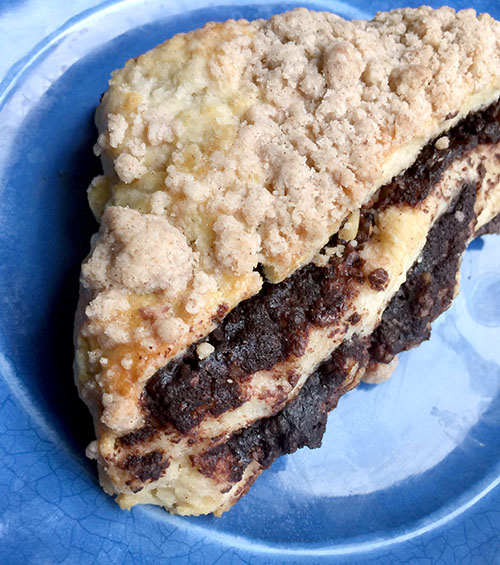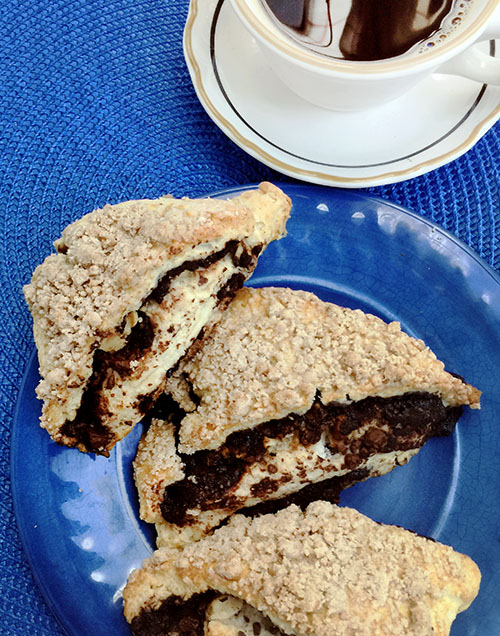
Fusion baking has become popular — taking two favorite baked goods and making one new hybrid, aka, the “scuffin,†cro-puff,†“cronut,†“pretzel challah.†Cookies have been turned into pizzas, and pies have been enlarged into sheet cake-sized “slabs.â€
Versatile and sturdy scones lend themselves very easily to some hybridized new version of another baked good in scone form. In February, I transferred the Linzer torte/cookie into a scone. And last September, I tried out Food52’s Cinnamon Scone Bread, that made a loaf into scones, or scones into a loaf (either way, it was some new, and very delicious, thing that got eaten quite quickly). Really, many breads, cookies, cakes, pies and other desserts could be “sconed,†and my mind has become a-swim with all the possibilities!
[D]uring this past Easter and Passover season, I considered making a chocolate babka, a chocolate-and-cinnamon swirled yeast bread topped with streusel, a tradition in Jewish baking, and then I thought…why not try a chocolate babka scone?
Certainly I had already made layered scones (with jam and the aforementioned scone bread that was scones stacked sideways and layered with streusel). I could make the traditional babka filling and topping and layer and swirl it into scone dough instead.
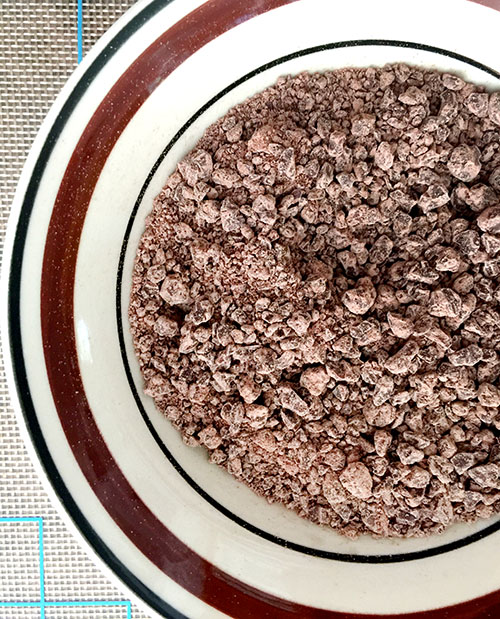
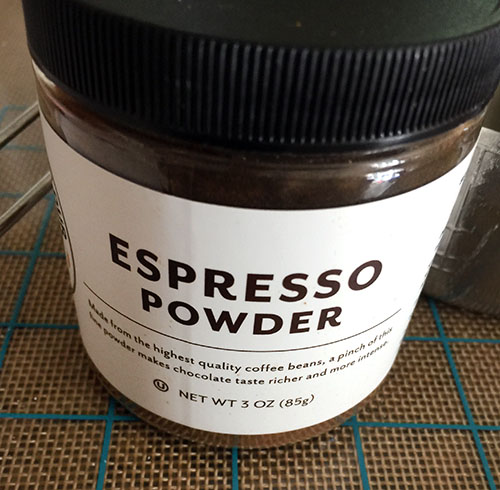
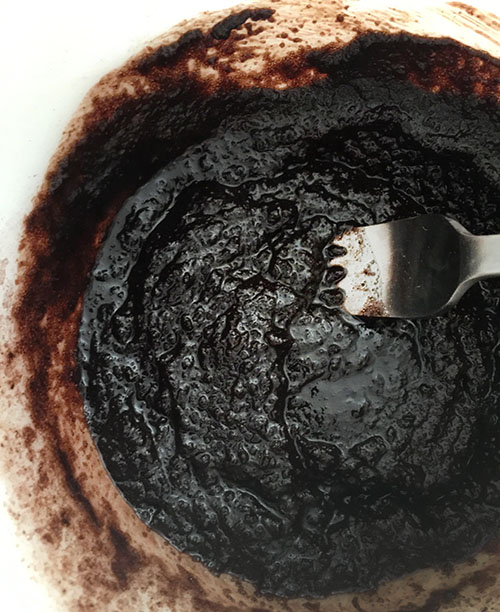
[I] found a recipe for chocolate babka and incorporated the filling recipe, darkly delightful with cocoa powder, espresso powder and cinnamon, sugar and melted butter. The filling would also incorporate a sprinkling of finely chopped chocolate (I blitzed chocolate chips in the blender for a bit) and toasted walnuts.
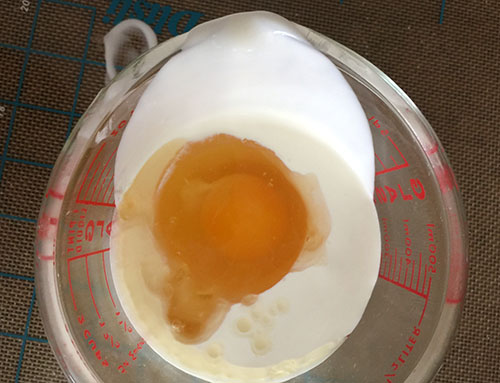

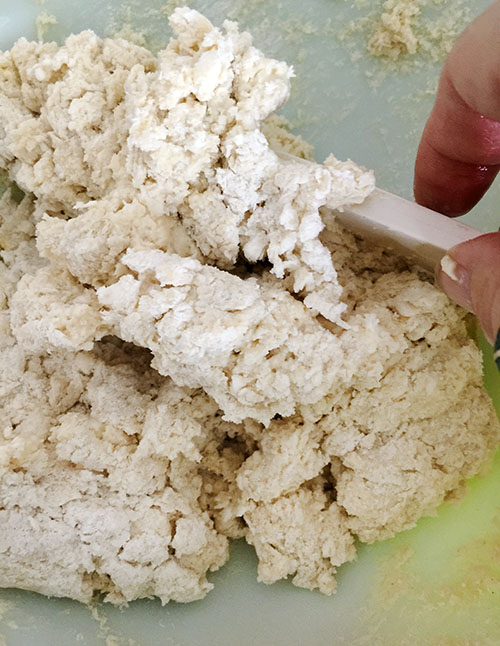
[I] picked a simple rendition of scone dough, a basic butter-egg-and-cream (cream tends to yield the most tender scones, I’ve found) formula, I added a couple of pinches of cinnamon (maybe 1/4 to 1/2 teaspoon) of cinnamon to the dry ingredients and some vanilla to the cream and egg to add some richness and spice to flavor the mild dough.
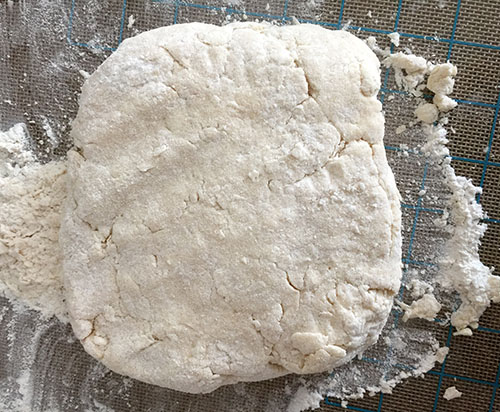
[I] let the dough rest in the refrigerator a bit while I heated the oven (about 375 degrees), got my baking sheet lined with parchment and made my streusel topping (an easy mix of confectioners’ sugar, cinnamon, flour and melted butter).
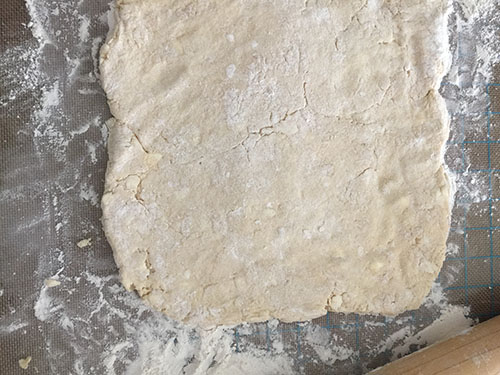
[I] rolled out the scone dough to about 1/4-inch thickness to approximately a 13-by-10-inch rectangle.
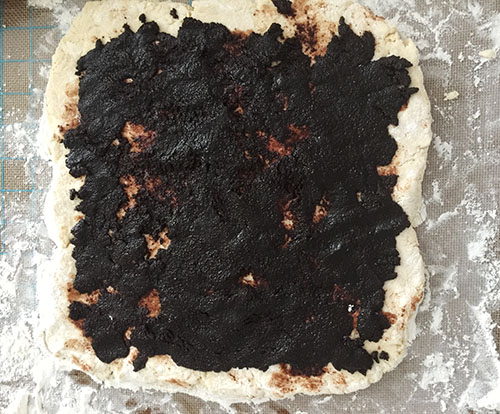
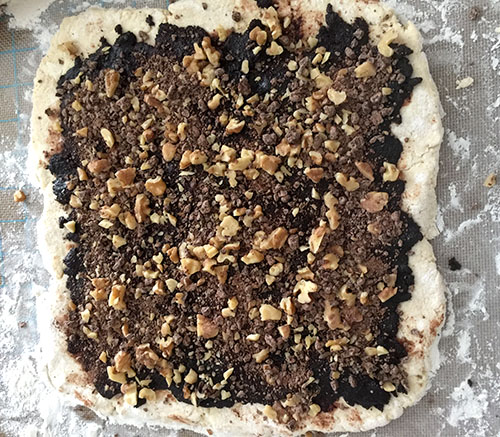
[I] spread the filling out on the sheet of dough and sprinkled the chocolate and walnuts over top of that, pressing the filling just slightly into the dough.
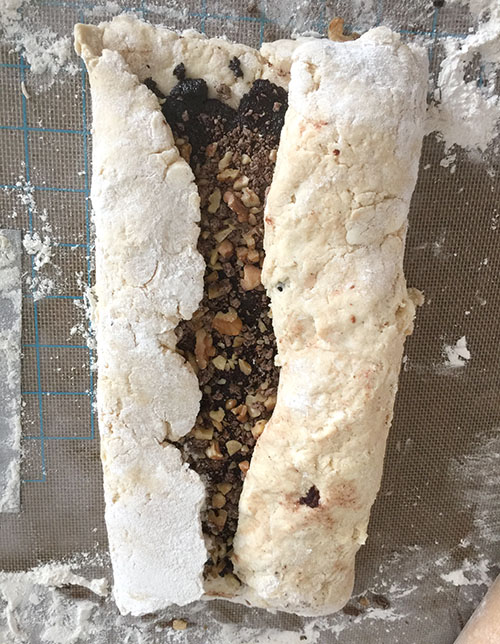
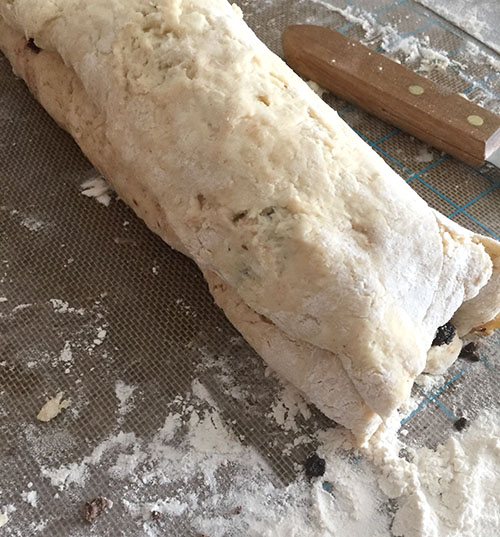
[S]tarting on one of the longer sides of the rectangle, and using my bench scraper to assist, I rolled/folded the dough twice to the halfway point of the rectangle; then I rolled from the other side to meet the first roll.
I gently folded one side on top of the other and flattened the whole roll so it resembled a long narrow rectangle (about four inches wide on the narrow end).
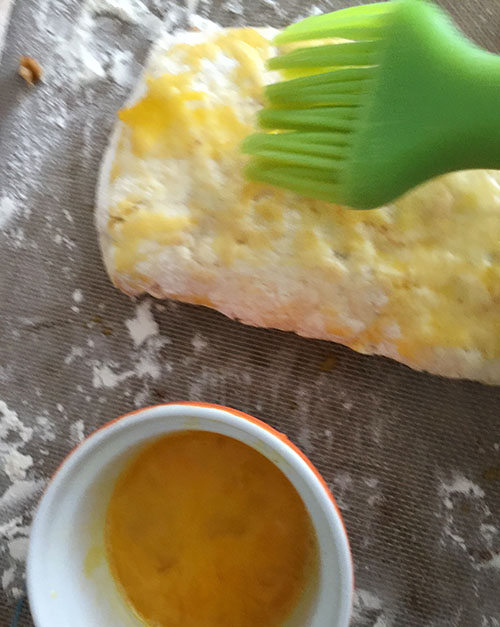
[I] brushed the rectangle with a egg beaten with a pinch of salt and sprinkled on my streusel topping, pressing that in slightly, also.
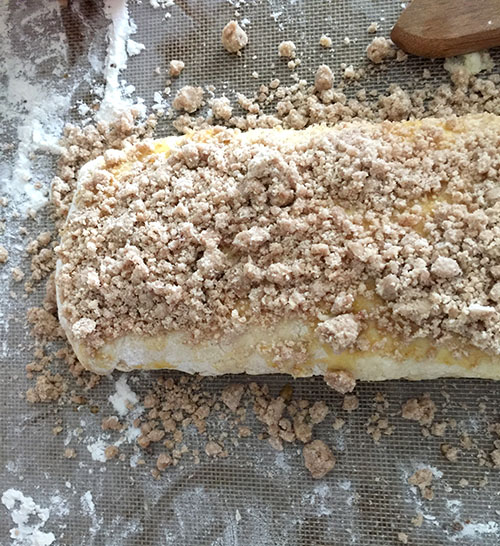
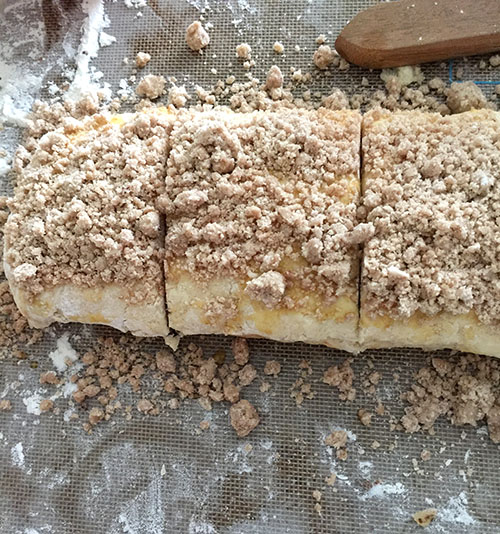
[I] cut the rectangle into four somewhat equal squares and cut each square diagonally to form a triangle. I placed each triangle about two inches apart on my baking sheet. The cut scones were beautifully marble-y, the deep, dark filling a lovely contrast to the creamy scone dough.
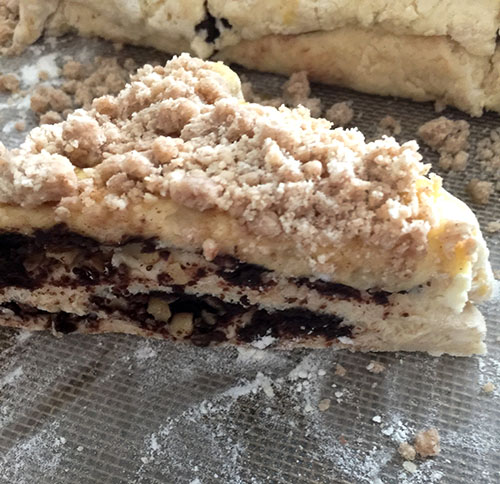
[W]ith all the layering and the filling, I did have concerns about he scones losing shape (as they do) and the filling running out of them. These are risks one must embrace when recipe-testing. I was fairly certain they would be tasty however their end structure turned out.
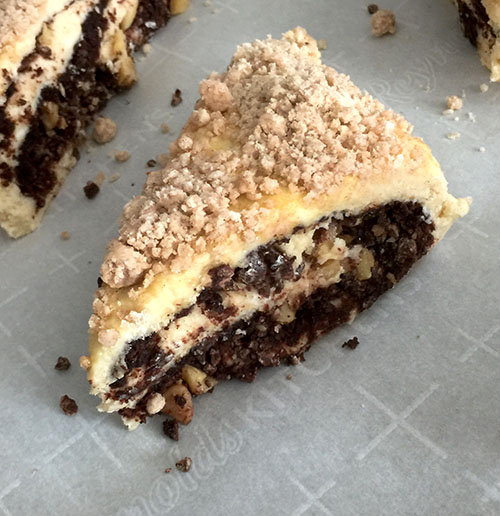
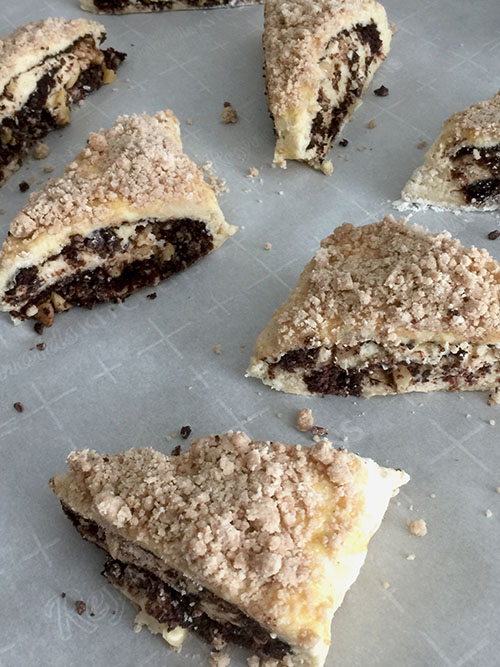
[T]he scones did slide off their foundations a little. This does happen and there are theories/solutions for it (make sure the cut scones are chilled or the dough has rested or when cutting the scones make sure the cuts are sharp so the layers are not squished on the sides). Any of those potential tips may still yield a slumped scone. My belief (excuse) is that is just what they do. While a lofty, layered stack may be prettier, the fact that there are many layers here, with filling, would tend to end up with the sliding/slumping of layers. I really could not allow myself to have a problem with this, given the buttery, cocoa/chocolate, cinnamon smell pervading my kitchen as I freed the scones from the oven to rest and cool.
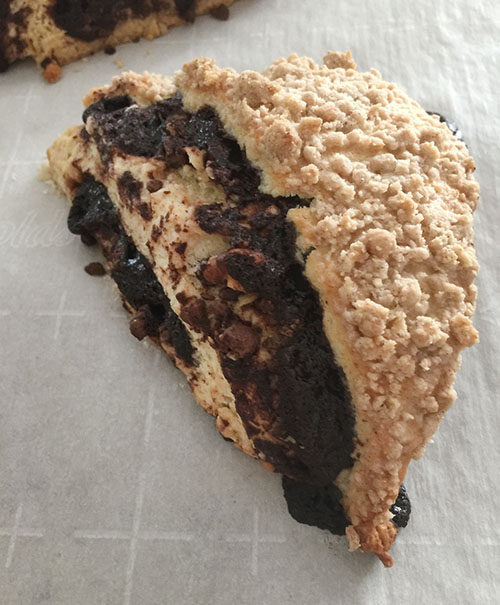
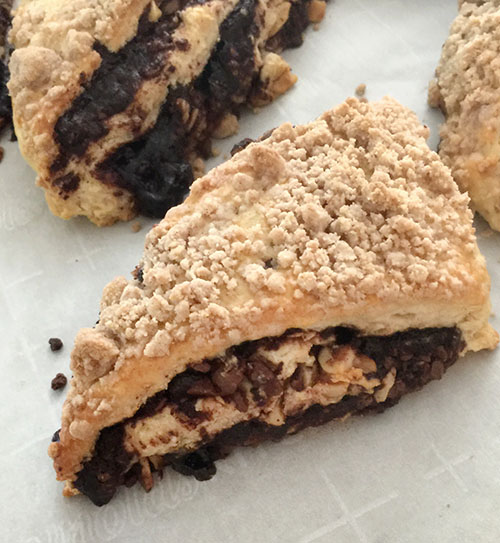
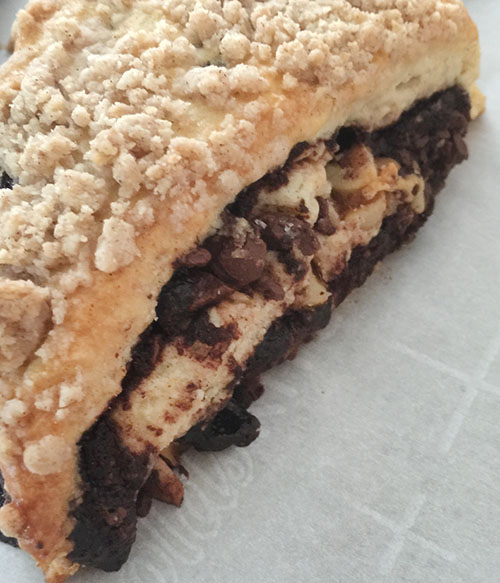
[I] will allow myself a little horn-tooting here…these scones are delicious. The dark chocolate filling, punctuated with coffee and cinnamon, is extra-rich and decadent with that crunchy layer of walnuts and melted chocolate. The simple scone dough is the perfect complement to the filling, extremely tender and even flaky, with that light crusty topping of cinnamon streusel. They reminded me a little of rugelach, those little rolled pastry-like cookies that sometimes have a chocolate filling (hmmm, rugelach scones?).
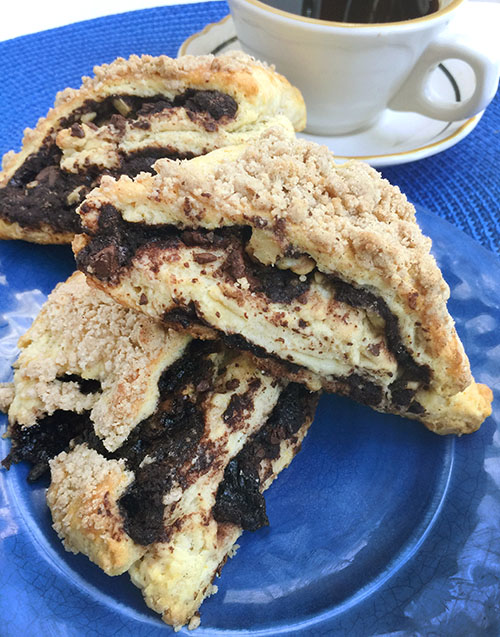
I do believe any babka would be proud to be related to this scone-y cousin.
Chocolate Babka Scones
Makes 8 large scones
For the filling:
- 1/2 cup sugar
- 1/2 teaspoon ground cinnamon
- 1/3 cup cocoa powder
- 1/2 teaspoon espresso powder
- 1/4 cup melted butter
- 1/2 cup dark chocolate, finely chopped
- 1/2 cup toasted walnuts, roughly chopped
For the dough:
- 2 1/2 cups all-purpose flour
- 1/4 cup granulated sugar
- 1 tablespoon baking powder
- 3/4 teaspoons kosher salt
- Pinch or two of ground cinnamon
- 6 tablespoons chilled unsalted butter, cut into cubes
- 1 cup heavy cream
- 1 large egg
- 1 1/2 teaspoon vanilla extract
For the glaze and streusel:
- One large egg, beaten with a pinch of salt
- 4 tablespoons melted butter
- 1/2 teaspoon ground cinnamon
- 2/3 cup confectioners’ sugar
- 1/2 cup all-purpose flour
Heat oven to 375 degrees. Line a large baking sheet (or two smaller ones) with parchment paper.
To make the filling, combine the sugar, cocoa, cinnamon and espresso powder in a small bowl. Add 4 tablespoons melted butter to thoroughly combine (it will resemble a paste). Keep walnuts and chopped chocolate in a separate bowl to sprinkle over filling on dough later.
Make the dough. In a large bowl, whisk together the flour, sugar, baking powder, salt and cinnamon. Blend in the cubes of butter (with a pastry blender or, if you prefer, a food processor) until the mixture looks to contain coarse crumbs.
Whisk the egg and vanilla into the cream. Gradually add the cream mixture to the dry ingredients, blending lightly using a fork until the dough begins to come together. Turn out onto a floured board or mat and gather the dough into a large square or ball (do not over-handle dough or it will be tough). Chill (for several minutes) while you make the streusel.
For the streusel, the in a small bowl, blend the cinnamon, confectioners’ sugar and cinnamon; add the melted butter and mix with a fork until resembles large crumbs.
Return the dough to a lightly floured board or mat. Either pat or roll the dough to1/4-inch thickness to about a 13-by-10 inch rectangle.
Spread the chocolate filling paste evenly over the dough, allowing for about a 1/2 inch margin on all sides. Sprinkle the chopped chocolate and walnuts over the filling, press lightly.
Starting on one long side, either roll or fold the dough over twice or until it is at the halfway point of the rectangle. From the other long side, fold until it meets the already rolled side. Fold one of the rolls over the other and flatten this into a long rectangle, about 4 inches by 13 inches.
Brush the rectangle with the beaten egg glaze. Sprinkle over the streusel and press lightly to adhere.
Cut the rectangle into four even squares. Cut each square across diagonally to form a triangle. Place each triangle about two inches apart on the lines baking sheet.
Bake for about 15 to 19 minutes or until golden brown. Remove to a rack to cool.
